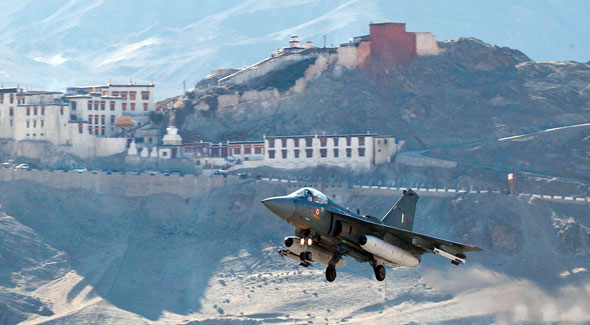SOURCE: AFI


In a strategic move to bolster its operational capabilities in the North-Eastern sector, the Indian Air Force (IAF) has deployed its indigenously developed Light Combat Aircraft (LCA) Tejas Mk1 to Leh, one of India’s most critical forward air bases in Ladakh. This deployment, initiated in recent months, aims to enhance the IAF’s readiness in the region amid ongoing border tensions with China along the Line of Actual Control (LAC). Additionally, the move serves as a preparatory step for the integration of the more advanced Tejas Mk1A variant, with squadrons expected to be formed in the coming years. The deployment underscores the IAF’s commitment to strengthening its presence in the challenging Himalayan terrain while transitioning to a more modern and self-reliant fighter fleet.
Leh, located at an altitude of over 11,000 feet, is a key air base for the IAF in the North-Eastern sector, providing a strategic vantage point to monitor and respond to activities along the LAC. The region has been a focal point of heightened military activity since May 2020, when India and China engaged in a military standoff in eastern Ladakh, leading to occasional skirmishes and casualties on both sides. The deployment of Tejas Mk1 aircraft to Leh enhances the IAF’s operational readiness in this high-altitude environment, where the thin air and rugged terrain pose unique challenges for both aircraft and personnel.
This move also aligns with the IAF’s broader strategy to optimize its force structure across India’s borders. By deploying the Tejas Mk1 in the North-Eastern sector, the IAF can free up longer-endurance aircraft like the Sukhoi-30MKI for other critical missions, particularly along the eastern border with China, where airbases are scarce and the terrain demands aircraft with greater range and payload capacity. The Tejas Mk1’s role as a point-defense fighter in Ladakh complements the IAF’s multi-layered approach to air defense, ensuring rapid response capabilities against potential threats in the region.
The deployment of Tejas Mk1 aircraft in Leh is not just a tactical response to current geopolitical tensions; it also serves as a crucial preparatory step for the induction of the Tejas Mk1A, an advanced variant of the Mk1. The IAF currently operates two squadrons of Tejas Mk1 aircraft—No. 45 Squadron (“Flying Daggers”) and No. 18 Squadron (“Flying Bullets”)—based at Sulur Air Force Station in Tamil Nadu. These squadrons, comprising 32 single-seat fighters and eight twin-seat trainers as of April 2025, have been progressively integrated into operational roles, including deployments to forward bases in the western sector since 2020.
The Tejas Mk1A, which incorporates over 40 improvements over the Mk1, is set to become a cornerstone of the IAF’s fighter fleet. The variant features advanced avionics, including the Israeli EL/M-2052 Active Electronically Scanned Array (AESA) radar (to be replaced by the indigenous Uttam AESA radar in later batches), an Electronic Warfare Suite with a Radar Warning Receiver (RWR) and Advanced Self-Protection Jammer (ASPJ), and the ability to carry Beyond Visual Range (BVR) missiles like the Astra Mk1. The first Tejas Mk1A aircraft was initially expected to be delivered by February 2024, but delays—primarily due to supply chain issues with GE Aerospace’s F404 engines—have pushed the timeline to March 31, 2025, with critical trials using Category B engines commencing in January 2025.
The IAF has ambitious plans for the Tejas Mk1A, with a total of 180 aircraft on order (83 from a 2021 contract worth ?48,000 crore and an additional 97 cleared in November 2023 at an estimated cost of ?65,848 crore). These aircraft will form up to ten squadrons, significantly boosting the IAF’s combat strength as it phases out aging platforms like the MiG-21, MiG-23, and MiG-27. The first Tejas Mk1A squadron is slated to be operational by the end of 2024 at Nal Air Force Station in Rajasthan, with subsequent squadrons planned for Naliya Air Base in Gujarat and potentially a third on the western border by mid-2025. However, the deployment of Tejas Mk1 in Leh signals the IAF’s intent to expand the Tejas family’s presence to the North-Eastern sector, where the Mk1A’s enhanced capabilities will be particularly valuable.
Operating the Tejas Mk1 in Leh allows IAF squadrons to gain critical experience in high-altitude operations, acclimatizing pilots and ground crews to the unique challenges of the region. This experience will be invaluable when the Tejas Mk1A is inducted, ensuring a seamless transition and rapid operationalization of the new variant in the North-Eastern sector. The Mk1A’s air-to-air refueling capability, advanced radar, and electronic warfare systems will enhance the IAF’s ability to maintain air superiority and conduct precision strikes in contested environments, addressing the growing threat posed by China’s J-20 stealth fighters and other advanced aircraft deployed near the LAC.
NOTE: AFI is a proud outsourced content creator partner of IDRW.ORG. All content created by AFI is the sole property of AFI and is protected by copyright. AFI takes copyright infringement seriously and will pursue all legal options available to protect its content.